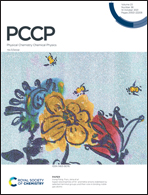Core level shifts as indicators of Cr chemistry on hydroxylated α-Al2O3(0001): a combined photoemission and first-principles study†
Abstract
The Cr/α-Al2O3(0001) interface has been explored by X-ray photoemission spectroscopy, X-ray absorption spectroscopy (XAS) and ab initio first-principles calculations of core level shifts including final state effects. After an initial oxidation via a reaction with residual surface OH but no reduction of the alumina substrate, Cr grows in a metallic form without any chemical effect on the initially oxidized Cr. However, Cr metal lacks crystallinity. Long-range (reflection high energy electron diffraction) and short-range (XAS) order are hardly observed. Thus photoemission combined with atomistic simulations becomes a unique tool to explore the chemistry and environment at the Cr/alumina interface. Cr 2p, O 1s and Al 2s shifted components are all explained by the formation of moieties involving Cr3+ and/or Cr4+ and of metallic Cr0, which supports the previously found Cr buffer mechanism for poorly adhesive metals. Beyond the situation under study, the present data demonstrate the ability of a combined experimental and theoretical approach of core-level shifts to exhaustively describe the general case of disordered metal/oxide interfaces.



 Please wait while we load your content...
Please wait while we load your content...